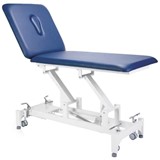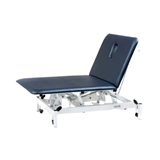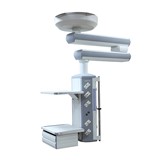Dental chair technology has come a long way since the early days of dentistry. Today, dental chairs are equipped with cutting-edge features and advancements that enhance patient comfort, improve treatment efficiency, and streamline dental procedures. Let's explore some of the remarkable innovations in dental chair technology that are transforming the dental industry.
1. Ergonomic Design and Patient Comfort
Modern dental chairs prioritize patient comfort with ergonomic designs and advanced cushioning materials. These chairs are contoured to support the natural posture of patients during treatments, reducing pressure points and minimizing discomfort. Adjustable headrests, armrests, and lumbar support allow dentists to customize the chair for each patient, fostering a relaxing and stress-free experience.
2. Electric Motors for Precise Positioning
Electric dental chairs have become increasingly popular due to their precise positioning capabilities. Electric motors allow for smooth and accurate adjustments, enabling dentists to position patients precisely for optimal access during treatments. The ability to program and recall preset positions enhances treatment efficiency by eliminating the need for manual adjustments between procedures.
3. Integrated Technology and Connectivity
Advancements in dental chair technology have facilitated seamless integration with other dental equipment and digital systems. Many modern dental chairs come equipped with integrated touch-screen panels, allowing dentists to control various dental instruments, lights, and imaging systems from a centralized interface. This integration streamlines the workflow within the operatory and enhances the overall treatment experience for both the dental team and patients.
4. Smart Features and Automation
Dental chairs are embracing smart technology to further improve the patient experience. Some chairs now feature smart sensors that detect patient movements and adjust the chair's position accordingly, ensuring patients remain comfortable throughout the procedure. Additionally, automation in dental chairs can significantly reduce manual tasks for dental assistants, freeing up valuable time and resources.
5. Hygiene and Infection Control
Maintaining a high level of hygiene is paramount in dental practice. Advanced dental chairs are designed with seamless and easy-to-clean surfaces, reducing the risk of cross-contamination. Some chairs feature removable and autoclavable components, ensuring thorough sterilization between patients. Additionally, anti-microbial materials are incorporated into the chair's design to further enhance infection control.
6. Noise Reduction and Quiet Operation
Innovations in dental chair technology have addressed the issue of noise during adjustments. Many modern dental chairs are designed with noise reduction features, ensuring quiet and smooth movements. This reduction in noise levels contributes to a more relaxing and comfortable environment for patients, alleviating dental anxiety.
7. Eco-Friendly Designs
Environmental consciousness is becoming increasingly important in various industries, including dentistry. Some dental chair manufacturers are incorporating eco-friendly materials and energy-efficient features into their designs. These eco-conscious chairs reduce the environmental impact of dental practices and align with sustainable practices.
8. Patient Entertainment and Comfort Options
Dental chair technology has also expanded into patient entertainment and comfort options. Some chairs now offer built-in multimedia systems, allowing patients to watch movies, listen to music, or browse the internet during treatments. Integrated heating and massage functionalities provide an added layer of comfort and relaxation, making dental visits more enjoyable for patients.
9. Artificial Intelligence and Data Analytics
The integration of artificial intelligence (AI) and data analytics in dental chairs is an emerging trend. AI-powered chairs can analyze patient data and provide valuable insights to dentists, aiding in treatment planning and decision-making. Data analytics can also help dental practices optimize their workflows and improve patient outcomes.
10. 3D Imaging and Intraoral Scanning Integration:
The integration of 3D imaging and intraoral scanning technology has revolutionized the field of dentistry, providing dental professionals with advanced diagnostic capabilities and treatment planning tools. This powerful combination allows for precise and detailed visualization of the oral structures, enabling more accurate diagnoses and improved patient outcomes. Let's delve into the significance and benefits of 3D imaging and intraoral scanning integration in modern dental practice.
-
Accurate and Comprehensive Diagnostic Imaging
3D imaging, such as cone-beam computed tomography (CBCT), provides detailed and three-dimensional views of the teeth, jawbones, and surrounding structures. CBCT scans offer superior image quality compared to traditional dental X-rays, allowing dentists to detect dental issues, bone abnormalities, and other oral conditions with exceptional accuracy.
-
Enhanced Treatment Planning
The integration of 3D imaging and intraoral scanning enables dentists to perform virtual treatment planning with precision. Intraoral scans capture the exact shape and size of teeth and soft tissues, while CBCT scans provide vital information about bone density and proximity to nerves. Combining this data allows dentists to create a comprehensive treatment plan and evaluate different treatment options before starting any procedure.
-
Improved Implant Placement
Intraoral scanning and 3D imaging have significantly improved the precision of dental implant placement. Dentists can use virtual implant planning software to identify the ideal implant location, ensuring proper alignment and optimal bone support. This technology minimizes the risk of complications during the implant procedure and increases the overall success rate of dental implants
11. Wireless Connectivity and Data Sharing Capabilities in Dentistry:
Wireless connectivity and data sharing capabilities have become essential features in modern dental technology. The integration of wireless technology in dental devices and equipment has revolutionized how dental professionals access, share, and utilize patient data. Let's explore the significance and benefits of wireless connectivity and data sharing capabilities in dentistry.
-
Efficient Data Transfer
Wireless connectivity allows for seamless and real-time data transfer between various dental devices and software systems. Intraoral scanners, digital X-ray machines, and other dental equipment can transmit patient data, images, and diagnostic information wirelessly to dental software platforms. This efficiency streamlines the workflow and minimizes the need for manual data entry, saving valuable time for dental professionals.
-
Cloud-Based Solutions
Wireless data sharing often involves cloud-based solutions, where patient data and images are securely stored on remote servers. This cloud-based approach enables dental professionals to access patient records and treatment plans from anywhere with an internet connection. Cloud storage ensures data backup, data security, and easy accessibility, fostering more flexible and mobile dental practices.
-
Enhanced Collaboration and Consultation
Wireless data sharing enables dental professionals to collaborate and consult with colleagues, specialists, and dental laboratories more effectively. Dentists can share patient data and images securely with specialists, seeking opinions and treatment recommendations without the need for physical data transfer. This collaboration fosters interdisciplinary care and improves treatment outcomes for patients.
12. Touchless Controls and Voice-Activated Features in Dentistry:
Touchless controls and voice-activated features have emerged as game-changing innovations in the field of dentistry. With an increasing focus on infection control and patient safety, these technologies offer a hands-free approach to dental equipment and operatory functions. Let's explore the significance and benefits of touchless controls and voice-activated features in modern dental practice.
-
Improved Infection Control
Touchless controls and voice-activated features eliminate the need for physical contact with dental equipment, reducing the risk of cross-contamination between patients. Dental professionals can adjust chair positions, lighting, and various settings without touching buttons or switches, ensuring a more hygienic operatory environment.
-
Enhanced Patient Safety and Comfort
Hands-free operation of dental equipment enhances patient safety and comfort. Patients may feel more at ease during treatments, knowing that the dental team is utilizing touchless controls to minimize contact. Additionally, patients with mobility challenges or special needs can benefit from voice-activated features, allowing them to communicate and participate in their dental care more easily.
-
Streamlined Workflow
Touchless controls and voice-activated features streamline the dental workflow, saving time for dental professionals. Dentists and dental assistants can focus on patient care and treatment procedures without interruption, as they can make adjustments to equipment settings and access patient records hands-free.
-
Voice-Activated Imaging and Data Entry
Voice-activated features enable dental professionals to perform imaging tasks and data entry more efficiently. For example, dentists can use voice commands to capture intraoral images or record treatment notes, reducing the need for manual input and increasing the accuracy of patient records.
Conclusion
Innovations and advancements in dental chair technology have revolutionized the dental industry, creating a new standard of patient care and comfort. From ergonomic designs and precise positioning capabilities to integrated technology and patient entertainment options, these advancements have significantly improved the dental experience for both patients and dental professionals. As technology continues to evolve, dental chair innovations will undoubtedly play an essential role in shaping the future of dentistry, enhancing treatment outcomes, and further elevating patient satisfaction.










-160x160-state_article-rel-cat.png)
















